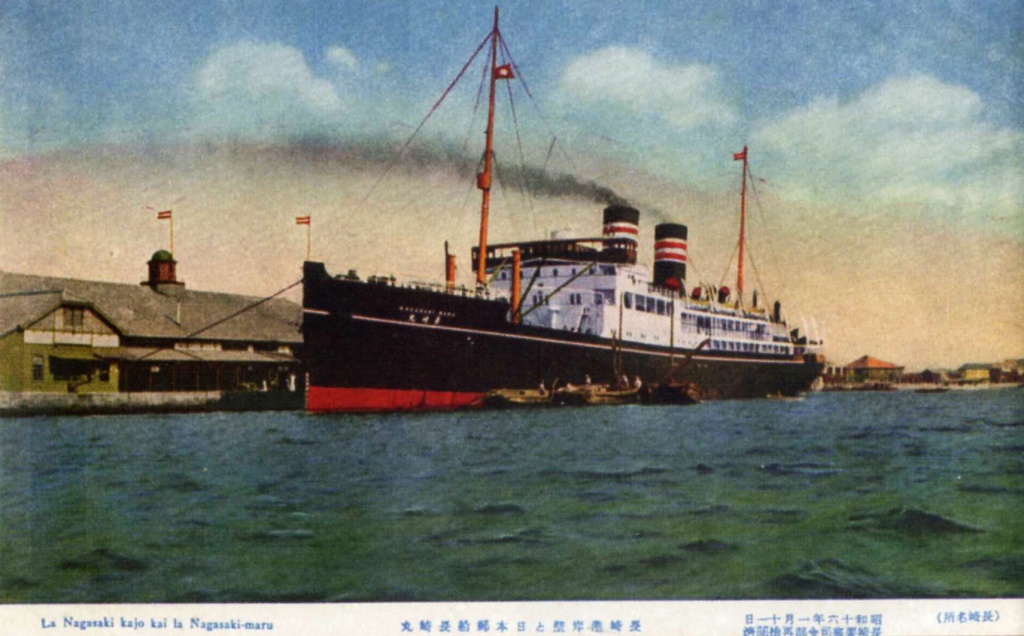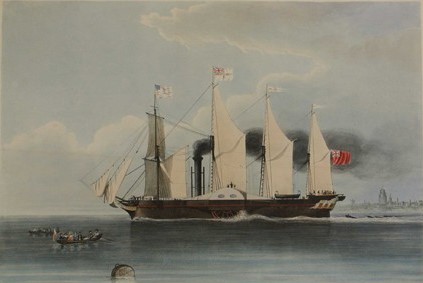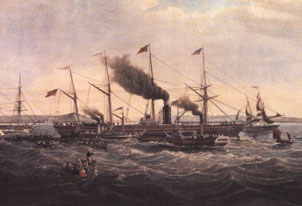|
History Of Steamship Lines
The shipping company is an outcome of the development of the steamship. In former days, when the packet ship was the mode of conveyance, combinations, such as the well-known Dramatic and Black Ball lines, existed but the ships which they ran were not necessarily owned by the organizers of the services. The advent of the steamship changed all that. Development In 1815 the first steamships began to ply between the British ports of Liverpool and Glasgow. In 1826 the ''United Kingdom'', a leviathan steamship, as she was considered at the time of her construction, was built for the London and Edinburgh trade, steamship facilities in the coasting trade being naturally of much greater relative importance in the days before railways. In 1823 the City of Dublin Steam Packet Company was inaugurated, though it was not incorporated until ten years later. The year 1824 saw the incorporation of the General Steam Navigation Company, which was intended not only to provide services in British wat ... [...More Info...] [...Related Items...] OR: [Wikipedia] [Google] [Baidu] |
Shipping Company
A shipping line or shipping company is a company whose line of business is ownership and operation of ships. Shipping companies provide a method of distinguishing ships by different kinds of cargo: # Bulk cargo is a type of special cargo that is delivered and handled in large quantities. # General cargo, now known as break-bulk cargo, refers to a wide assortment of goods that may be delivered to several ports around the world. # Oil became a crucial part of the shipping industry in the early 20th century. Its use varied from lubrication for developed machinery, burning in boilers and industrial plants, as well as for operating engines. Oil is also primarily shipped by specific shipping companies as opposed to other forms of transportation. This is considered a type of special cargo. The shipping of oil has become a debated issue due to the environmental impacts of both oil spills and oil tankers. # Passenger cargo is the business of transporting people on shipping lines for ... [...More Info...] [...Related Items...] OR: [Wikipedia] [Google] [Baidu] |
British And American Steam Navigation Company
The British and American Steam Navigation Company was a steamship line that operated a regular transatlantic service from 1839 to 1841. Before its first purpose-built Atlantic liner, ''British Queen'' was completed, British and American chartered ''Sirius'' for two voyages in 1838 to beat the Great Western Steamship Company into service. B & A's regular liners were larger than their rivals, but were underpowered. The company collapsed when its second vessel, ''President'' was lost in 1841. History British and American was founded by American lawyer Junius Smith (1780–1853), who is often considered the "Father of the Atlantic Liner". Smith had been a merchant in London for 30 years when in 1832 he became stuck on a sailing packet to New York for 54 days. The normal westbound passage was 40 days. Before he returned to London, he published the idea of building a line of transatlantic steamships in a November 1832 issue of the ''American Rail Road Journal''. His plan cal ... [...More Info...] [...Related Items...] OR: [Wikipedia] [Google] [Baidu] |
Martha's Vineyard
Martha's Vineyard, often simply called the Vineyard, is an island in the Northeastern United States, located south of Cape Cod in Dukes County, Massachusetts, known for being a popular, affluent summer colony. Martha's Vineyard includes the smaller adjacent Chappaquiddick Island, which is usually connected to the Vineyard. The two islands have sometimes been separated by storms and hurricanes, which last occurred from 2007 to 2015. It is the 58th largest island in the U.S., with a land area of about , and the third-largest on the East Coast, after Long Island and Mount Desert Island. Martha's Vineyard constitutes the bulk of Dukes County, which also includes the Elizabeth Islands and the island of Nomans Land (Massachusetts), Nomans Land. The Vineyard was home to one of the earliest known deaf communities in the United States; consequently, a sign language, the Martha's Vineyard Sign Language, emerged on the island among both deaf and hearing islanders. The 2010 census report ... [...More Info...] [...Related Items...] OR: [Wikipedia] [Google] [Baidu] |
SS Republic (1872)
SS ''Republic'' was an ocean liner built in 1871 by Harland and Wolff for White Star Line. It was intended to be the last of four vessels forming the Oceanic-class, before two new ships were commissioned. After a rough maiden voyage from Liverpool to New York City on 1 February 1872, the ship was chosen to be on White Star Line's first voyage on the South Atlantic and Pacific line with four other ships, destined for Chile. In 1874, the construction of modern ships SS ''Germanic'' and SS ''Britannic'' led to SS ''Republic''s becoming the standby vessel of White Star Line. It occupied this position for 15 years, and attempts were made to modernise it in 1888. When RMS ''Teutonic'' and RMS ''Majestic'' entered service in the following year, the ''Republic'' became surplus to White Star's needs. ''Republic'' was sold in 1889 to Holland America Line and was renamed ''Maasdam'', and served with the company for twelve years. In 1902, it was sold to Italian company La Veloce where i ... [...More Info...] [...Related Items...] OR: [Wikipedia] [Google] [Baidu] |
White Star Line
The White Star Line was a British shipping company. Founded out of the remains of a defunct packet company, it gradually rose up to become one of the most prominent shipping lines in the world, providing passenger and cargo services between the British Empire and the United States. While many other shipping lines focused primarily on speed, White Star branded their services by focusing more on providing comfortable passages for both upper class travellers and immigrants. Today, it is remembered for the innovative vessel and for the losses of some of their best passenger liners, including the wrecking of in 1873, the sinking of in 1909, the infamous loss of in 1912 and the wartime sinking of in 1916. Despite its casualties, the company retained a prominent hold on shipping markets around the globe before falling into decline during the Great Depression, which ultimately led to a merger with its chief rival, Cunard Line, which operated as Cunard-White Star Line until 1950 ... [...More Info...] [...Related Items...] OR: [Wikipedia] [Google] [Baidu] |
SS Great Eastern
SS ''Great Eastern'' was an iron sail-powered, paddle wheel and screw-propelled steamship designed by Isambard Kingdom Brunel, and built by John Scott Russell & Co. at Millwall Iron Works on the River Thames, London. She was the largest ship ever built at the time of her 1858 launch, and had the capacity to carry 4,000 passengers from England to Australia without refuelling. Her length of was surpassed only in 1899 by the 17,274-gross-ton , her gross tonnage of 18,915 was only surpassed in 1901 by the 20,904-gross-ton and her 4,000-passenger capacity was surpassed in 1913 by the 4,234-passenger . The ship having five funnels (which were later reduced to four) was unusual for the time. The vessel also had the largest set of paddle wheels. Brunel knew her affectionately as the "Great Babe". He died in 1859 shortly after her maiden voyage, during which she was damaged by an explosion. After repairs, she plied for several years as a passenger liner between Britain and North Ame ... [...More Info...] [...Related Items...] OR: [Wikipedia] [Google] [Baidu] |
Decade
A decade () is a period of ten years. Decades may describe any ten-year period, such as those of a person's life, or refer to specific groupings of calendar years. Usage Any period of ten years is a "decade". For example, the statement that "during his last decade, Mozart explored chromatic harmony to a degree rare at the time" merely refers to the last ten years of Wolfgang Amadeus Mozart's life without regard to which calendar years are encompassed. Also, 'the first decade' of a person's life begins on the day of their birth and ends at the end of their 10th year of life when they have their 10th birthday; the second decade of life starts with their 11th year of life (during which one is typically still referred to as being "10") and ends at the end of their 20th year of life, on their 20th birthday; similarly, the third decade of life, when one is in one's twenties or 20s, starts with the 21st year of life, and so on, with subsequent decades of life similarly described by ref ... [...More Info...] [...Related Items...] OR: [Wikipedia] [Google] [Baidu] |
SS British Queen
''British Queen'' was a British passenger liner that was the second steamship completed for the transatlantic route when she was commissioned in 1839. She was the largest passenger ship in the world from 1839 to 1840, then being passed by the . She was named in honor of Queen Victoria and owned by the British and American Steam Navigation Company. ''British Queen'' would have been the first transatlantic steamship had she not been delayed by 18 months because of the liquidation of the firm originally contracted to build her engine. As the largest ship in the world, ''British Queen'' was roomier and more comfortable than her contemporaries. She never won the Blue Riband but matched ''Great Western's'' westbound speeds from 1838 through 1840 and was less than a half of a knot slower eastbound. After completing nine round trip voyages, ''British Queen'' was laid up in 1841 when British-American steam navigation traffic collapsed due to the loss of the ''President'' with all on bo ... [...More Info...] [...Related Items...] OR: [Wikipedia] [Google] [Baidu] |
SS Great Western
SS ''Great Western'' of 1838, was a wooden-hulled paddle-wheel steamship with sails the first steamship purpose-built for crossing the Atlantic, and the initial unit of the Great Western Steamship Company. She was the largest passenger ship in the world from 1837 to 1839, which was then passed by the . Designed by British civil engineer Isambard Kingdom Brunel, ''Great Western'' proved satisfactory in service and was the model for all successful wooden Atlantic paddle-steamers. She was capable of making record Blue Riband voyages as late as 1843. ''Great Western'' worked to New York for 8 years until her owners went out of business. She was sold to the Royal Mail Steam Packet Company and was scrapped in 1856 after serving as a troop ship during the Crimean War. Development and design In 1836, Isambard Brunel, his friend Thomas Guppy and a group of Bristol investors formed the Great Western Steamship Company to build a line of steamships for the Bristol-New York route. The ide ... [...More Info...] [...Related Items...] OR: [Wikipedia] [Google] [Baidu] |
Great Western Steamship Company
The Great Western Steam Ship Company operated the first regular transatlantic steamer service from 1838 until 1846. Related to the Great Western Railway, it was expected to achieve the position that was ultimately secured by the Cunard Line. The firm's first ship, ''Great Western'' was capable of record Blue Riband crossings as late as 1843 and was the model for Cunard's ''Britannia'' and her three sisters. The company's second steamer, the ''Great Britain'' was an outstanding technical achievement of the age. The company collapsed because it failed to secure a mail contract and ''Great Britain'' appeared to be a total loss after running aground. The company might have had a more successful outcome had it built sister ships for ''Great Western'' instead of investing in the too advanced ''Great Britain''. History By the 1830s, Liverpool was overtaking Bristol as a transatlantic port. The Great Western Railway was formed in 1833 to build a Bristol-London line and appointed ... [...More Info...] [...Related Items...] OR: [Wikipedia] [Google] [Baidu] |
Thames
The River Thames ( ), known alternatively in parts as the River Isis, is a river that flows through southern England including London. At , it is the longest river entirely in England and the second-longest in the United Kingdom, after the River Severn. The river rises at Thames Head in Gloucestershire, and flows into the North Sea near Tilbury, Essex and Gravesend, Kent, via the Thames Estuary. From the west it flows through Oxford (where it is sometimes called the Isis), Reading, Henley-on-Thames and Windsor. The Thames also drains the whole of Greater London. In August 2022, the source of the river moved five miles to beyond Somerford Keynes due to the heatwave in July 2022. The lower reaches of the river are called the Tideway, derived from its long tidal reach up to Teddington Lock. Its tidal section includes most of its London stretch and has a rise and fall of . From Oxford to the Estuary the Thames drops by 55 metres. Running through some of the drier parts of mai ... [...More Info...] [...Related Items...] OR: [Wikipedia] [Google] [Baidu] |
SS Royal William
SS ''Royal William'' was a Canadian side-wheel paddle steamship that is sometimes credited with the first crossing of the Atlantic Ocean almost entirely under steam power, in 1833, using sails only during periods of boiler maintenance. She was the largest passenger ship in the world from 1831 to 1839, where it was then passed by the . Earlier vessels that crossed partially under steam include the British-built Dutch-owned ''Curaçao'' in 1827 and the sail-steam hybrid in 1819. The 1,370-ton SS ''Royal William'' (named after the ruling monarch, William IV) was long, of breadth and had a draught of 17¾ft, a large steamship for the time. She was drawn by 21-year old James Goudie who had by then served his apprenticeship, likely at Scotts Shipbuilding and Engineering Company of Greenock, Scotland, a seaport on the Firth of Clyde and also the birthplace of James Watt. History Genesis She was commissioned by brewer John Molson, George Black and John Saxton Campbell and a group ... [...More Info...] [...Related Items...] OR: [Wikipedia] [Google] [Baidu] |

.jpg)






